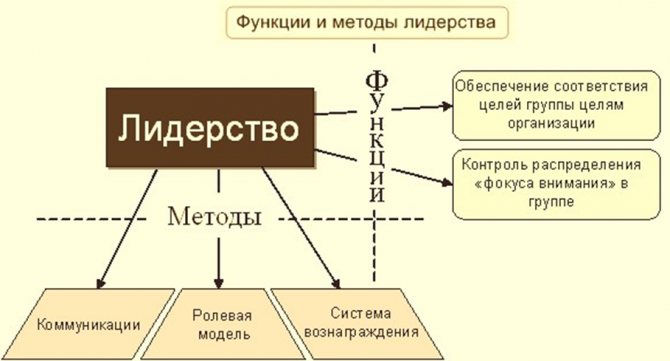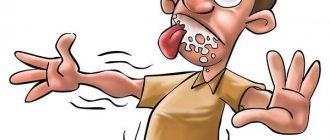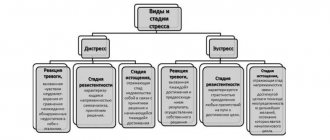The essence of leadership in management
The phenomenon of leadership accompanies humanity throughout the history of its existence.
Scientists have also been paying attention to it for hundreds of years. Despite the increased interest in leadership, a unified approach to defining its essence has not yet been developed. To date, there are over 350 definitions of this term. Let's look at the concept of leadership in management in more detail. Leadership in a general sense is usually understood as the status (position) of an individual in a group or community, which allows the individual to influence other people, thus directing their efforts to achieve certain goals.
Definition 1
A leader is a person who is a member of a certain group and who is capable of influencing the behavior of other group members in significant situations.
In management, a leader is also usually understood as a member of an organized group (team), to whom it recognizes certain rights in terms of decision-making in situations at any level. This is an authoritative person in the group who is assigned a system-forming role in joint activities and regulation of group relationships. The main elements of leadership are presented in Figure 1.
Finished works on a similar topic
- Course work Leadership of a manager 480 rub.
- Abstract Managerial Leadership 220 rub.
- Test work Leadership of a manager 200 rub.
Receive completed work or specialist advice on your educational project Find out the cost
Figure 1. Basic elements of leadership. Author24 - online exchange of student work
The foundation of leadership is the position of dominance, influence and subordination to the leader of interpersonal group relationships in their organized, ordered totality. The very phenomenon of leadership is impossible without the influence that arises between people in a group (organization). Such influence is multidirectional and organized.
At the same time, leadership is the interaction between the leader and other individuals in the group. People involved in such interaction, as a rule, strive for constant changes, the creation of conditions for the implementation of which involves leadership.
Finally, leadership is a special type of human activity, different from management, planning and any administrative paperwork. It arises directly between people, and does not come from outside. Without the existence of organized groups, leadership is impossible.
Too lazy to read?
Ask a question to the experts and get an answer within 15 minutes!
Ask a Question
In practice, leadership is often confused with management. The most common mistakes when defining this term are:
- identification of a leader with an entrepreneur;
- unconditional recognition by the leader of the person appointed to a managerial position (his identification with the manager);
- vision of the basis of knowledge leadership;
- comparison of a leader with a pioneer.
Summarizing all of the above, the essence of leadership can be defined as follows. Leadership is a type of managerial interaction between a leader and his followers. It is based on the use of the most effective combination of various sources of power for a particular situation, aimed at encouraging individuals to achieve common goals.
We all understand that every manager, by definition, is a leader who must lead the team.
However, many managers have a rather vague idea of what functions they should perform and are based only on past experience (which is not always successful) or on the experience of communicating with other managers. Because of this, the following negative effects may occur:
- discrepancies between the expectations of employees and the actions of the manager, which may lead to dissatisfaction among the team;
- ineffective performance of their duties, which will entail a drop in the efficiency of the entire department.
For this reason, the manager needs to have a clear understanding of those functions that, although not spelled out in his job responsibilities, must be performed by him in order to maintain a healthy psychological atmosphere in the team. In addition, understanding the full range of leadership responsibilities will help you understand which qualities you have developed well, which are your strengths, and which need improvement.
Psychology describes a large number of functions of leaders, but we will look at those that are especially relevant for managers and are tools for managing a team, as well as increasing the efficiency of its work.
Leader functions
Leader as administrator
This is one of the simplest and most obvious functions of a leader, which is to coordinate the work of the group. It is he who distributes labor resources, instructing one or another member of the team to perform a certain part of the work. In this case, the task is to distribute the workload of the department/organization as efficiently as possible, taking into account the abilities and skills of each member of the group.
The following errors occur when the administrator function is performed incorrectly:
- The leader does not distribute the work, but takes it upon himself. As a result, employees lose a sense of responsibility for their work, and their involvement in the common cause decreases.
- The leader overloads or underloads some employees. As a result, we have a situation where irritation accumulates in the organization, and the effectiveness of both those who are overloaded (due to constant fatigue) and those who do not do enough work (little motivation) is lost.
Leader as strategist
It is the manager who must know the long-term and short-term goals of the department. It should represent both the final result of the department’s work and the path that leads to it. Based on this, he organizes the work of the department, motivating his subordinates. It is important to note that department heads must know not only the goals of their departments, but also the goals of the entire organization, and constantly ensure that they comply with them.
Ignoring this function leads to the fact that, firstly, it directly leads to a decrease in the quality of work, which will be reduced only to solving immediate problems. Secondly, sooner or later, employees of any organization (as they burn out professionally) will ask the question “Why are we even working?” and they can get an answer to this question only by having a final goal, a guideline that will motivate them.
Leader as expert
Undoubtedly, it is the manager who his subordinates turn to in the event of any difficult situation for his competent opinion. Very often, the first criterion for selecting a candidate for a managerial position is precisely his competence in a certain field. In addition, the leader's opinion is often the most significant in the discussion of any important issue, since it is he who can give the most professional answer.
A leader who is not an expert in his field is usually not taken seriously by staff, has no authority among subordinates, and often cannot fully perform all other functions.
Leader as group representative
It is the leader who is the official representative of his team in the organization: he expresses the opinion of the group and represents its interests. The manager must both be able to summarize the opinions/needs/requests of his employees, and be able to express and defend them to other departments. That is why it is extremely important for group members who and how will represent them.
If the leader does not perform this function, the interests of the group often remain infringed, which leads to disappointment and gradual demotivation of employees. It is also possible that employees begin to try to express their needs “over the head” of the manager, which poses a direct threat to his authority.
Leader as a regulator of relationships
The leader is the regulator of relationships in the group, both business and interpersonal. What is interesting is that if the regulation of business relations is, as a rule, successful, then many managers do not even undertake the regulation of interpersonal relations, believing that this is not within their competence.
However, quite often it is the manager who can help resolve difficult situations that arise between employees. This is especially important in serious situations, such as a protracted conflict between two subordinates, or the division of a team into opposing groups.
In these cases, the manager is simply obliged to do everything to reconcile the parties with each other or organize such interaction between them that would exclude the emergence of conflicts.
The leader as a source of rewards and punishments
Naturally, it is the manager who determines both the amount and method of motivating employees, and possible deprivations for mistakes in work. It is important that motivation is adequate and predictable for all employees, both positive and negative.
In addition, it is desirable to use a variety of methods of encouragement, in addition to standard material motivation. Often money, which is often considered the most effective way to motivate employees, does not have the desired effect, and the manager needs to look for other, more effective ways. This could be motivation by a possible promotion, competitions held in the department, verbal encouragement, training opportunities and much more.
Leader as an example
As we know, very often employees in their work are guided by their leader, his views and work style. Naturally, his attitude towards work and the organization must be exactly the same as what he expects from his subordinates.
An active and purposeful leader not only sets an example, but also energizes his employees, or (if these are unmotivated subordinates) at least does not allow them to relax. A leader who demands from his subordinates what he himself never does, as a rule, has low authority in the team.
These are the main functions that a manager must undertake in order to maintain the motivation of his subordinates and ensure high efficiency of the department.
Healthy
If you need to conduct training on management skills for managers, you can order the “Effective Leadership” training. In it we will look at types of management, different types of teams, methods of management and common mistakes of managers.
Manager Leadership Functions
Traditionally, the most classic functions of leadership as such include:
- integrative function;
- communicative function;
- orientation function;
- mobilization function;
- instrumentalist function.
The first presupposes the need to unite group members under a common goal (idea), coordinate their interests and define basic values. The second is focused on creating strong connections both between group members and with external objects. The third is based on achieving set goals taking into account social interests (it is most important for political leadership).
The fourth (mobilization) function involves encouraging group members to take actions necessary to achieve their goals. Finally, the fifth (instrumentalist) function is associated with the need to develop a set of tools to solve the problems facing the group.
Being one of the most important aspects of management activities, managerial leadership also performs certain functions. Their basic set is presented in Figure 2. Let us consider them in more detail.

Figure 2. Leadership functions in management. Author24 - online exchange of student work
In management, leadership is focused primarily on organizing team members and adjusting their actions. A leader's responsibilities traditionally include setting clear goals, coordinating the team's overall efforts, and presenting results.
The second fundamental function is the motivation of subordinates - members of the team. This function involves the need to inspire group members to achieve their goals and instill in them confidence in their own abilities. In practice, it is often realized through achieving group synergy.
The third basic function of a manager's leadership is to represent and defend the interests of the group outside the team. It presupposes the need to determine the prospects for the group’s future activities and its development, as well as maintaining a balance between the group’s needs and the possibilities of meeting them.
Note 1
It is believed that in order to successfully perform the functions presented above, a manager-leader must have excellent communication skills, strong personal and professional qualities that allow him to manage people and be a kind of example for them, both professionally and emotionally.





